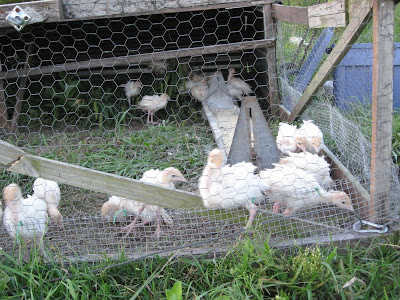A view of the south pasture (looking west) from atop the hay bales
Janice and Hazel have spent some time off the farm around the holidays. This has left me to my own devices for 11 days to do things about the farm. Admittedly, I was not all that productive, but I did mange to clean out my chicken building and brooders, just in time to start lambing. Two ewes lambed, but one ewe did not survive. I brought her lamb into the house for the first night and then drafted the lamb onto the first ewe that lambed. I had never done this before, but I had read about it a few times. I built a headlock in the building and put the ewe into it. The headlock has boards extending out from it to make sure the ewe cannot look back at the lambs suckling. It took a little time, but she accepted the lamb.
Surviving Ewe and the lambs, the white ram is the adopted lamb
Unfortunately, we have lost a total of three ewes in a short span. The one died in labor and the others were older and less compensative and could not keep-up with the heard despite my efforts to slip them some extra assistance. The remaining sheep look pretty good and will likely come through winter fine. We still have a number of ewes left to lamb likely within the next six weeks.
The flock at dinner time, the little shelter now has a steel roof on it
While Janice and Hazel were away, I did work on the tractor some. I got new tires put on the front end, it was miracle that the old ones did not go out on me, and put a new battery in it. Of course, after doing those things it does not want to run now, so I have to find some time to play with the wiring a bit. Something is likely loose somewhere. Jim from Pella came out twice and we started to clear out the less desirable trees from behind the house.
More tree clearing behind the house
When Janice and Hazel got back we did get to open some presents, although Hazel mostly wanted to eat wrapping paper and play with the cat. It is amazing how much hair Hazel grew in 11 days. She also get about a pound heavier, moves around much better, and has learned to awkwardly wave at people.
Janice, Hazel, & Nermal open presents
The last big piece of news is that I got a job two days ago with the Natural Resource Conservation Service (NRCS) in Newton as a part-time temporary Program Specialist. I will start as soon as the paperwork can all get approved. Since it is a federal job, it might take two weeks. I am not entirely sure what that will mean for the farm next year. There is considerable flexibility in scheduling with this job, but some things will have to go.
I am committed to cutting few things right now. I will be getting rid of my three large greeter turkeys and I am going to cull down my sheep herd. We purchased a number of lower quality ewes to breed to our high quality ram. Those ewes that perform well will stay, those that struggle will go. I will also be culling for size, condition, and ability to twin. I expect the ewe herd might shrink by as much as 1/3 to 1/2. It might be painful, but it will mean less work and higher quality in the long run. Other then these changes, I cannot say what outside employment will mean. I know that personally, I feel that we carry too much debt (buying a farm is rather expensive) and this is a way to pay off some of of those debts and create more breathing room in our finances. We shall see what 2011 has to hold for us, but I am hopeful and look forward to the possibilities.
The herd at hay feeding time





















































